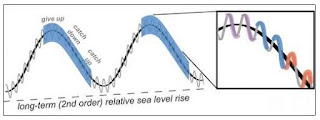Incisions are stratigraphically important in that they record
removal of previously deposited strata, and can represent sequence boundaries.
Here, Ullah et al. describe scour surfaces at the top of the Ferron Sandstone Member
(Cretaceous, Mancos Shale Formation, Henry Mountains, Utah) that include
individual channel stories. This study shows that confluence scours have
diagnostic fill facies (single set of large steep foresets) and do not produce
multi-storey sand bodies. The results, coupled with modern analog studies,
suggest that the maximum depth of confluence scours by autogenic process may
reach up to four to five times the average depth of the incoming channels. Consequently,
allogenic incised valleys (e.g., at sequence boundaries) can be defined in
ancient systems only in situations wherein the erosional relief is more than
five times average channel depth, markedly deeper than the thickest fully
preserved storys, which in a braided stream are likely to represent confluence
scour fills. Examples of autogenic modification of allogenically formed incised
valleys suggest that both allogenic forcing and autogenic feedback can act
simultaneously in fluvial systems.
A lasting question in carbonate geology asks how isolated
platforms—the sites of prolific and rapid sedimentation—can drown. To
explore how platform drowning occurs, Minzoni et al. document patterns within
backstepping platform margin architecture that led up to the drowning of the
Yangtze Platform (Triassic, South China). Results reveal that a
combination of mechanisms—anoxic basin development and tectonic subsidence/syndepositional
faulting—led to drowning of the platform by sinking into toxic bottom
waters. Although such a combination of mechanisms is not commonly
interpreted as cause of platform demise, the abundance of anoxic tectonically
active basins in the stratigraphic record suggests that the combination may be
a widespread cause of platform drowning, and patterns of architecture and
evolution documented here provide criteria for recognizing tectonically induced
drowning in other basins. Finally, the paper philosophically explores the
tragedy of platform drowning, and the sense of loss felt at yet another
perfectly good platform gone under.
Drowning of
the Triassic Yangtze Platform, south China, by tectonic subsidence into toxic
deep waters of an anoxic basin by Marcello Minzoni, Daniel J. Lehrmann,
Erich Dezoeten, Paul Enos, Paul Montgomery, Adrian Berry, Yanjiao Qin, Yu
Meiyi, Brooks B. Ellwood, and Jonathan L. Payne
Many studies
of fluvial systems utilize one-dimensional profiles (measured sections) and
bedding and facies architecture to predict 3D architecture and grain size
change. Here, Wu et al. use extensive plan-view exposures coupled with
vertical cliff exposures to document channel plan-form, channel-belt dimension,
bar migration patterns (translation versus expansion), and cross-sectional
facies architecture in the Cretaceous Ferron Notom Delta complex. The data
reveal the presence and dominance of small-scale unit bars on point-bar
deposits. Commonly under-recognized in ancient deposits, these unit bars
are ubiquitous features of modern fluvial systems, and may form important parts
of fluvial reservoirs.
Rapid tectonic and climate changes can
markedly influence lake extent and character, with distinct expression along-
and across-strike. Ghinassi et al.
suggest that although the morphological along-strike variability of lacustrine
coasts is relatively well understood, the nature and signature of this
variability on the sedimentological and stratigraphic record of lacustrine
systems is poorly documented. This study documents how lacustrine water-level
oscillations are recorded in different depositional systems along strike in
late Holocene shoreline deposits of Lake Hayk of Ethiopia. The results
illustrate low-relief margins with fluvial-deltaic systems and high-relief
margins with collvial fan deltas and stromatolitic biostromes. The data reveal
possible pitfalls of classical stratigraphic approaches used to establish
along-strike correlation between lacustrine sedimentary successions, important
for paleoenvironmental studies, subsurface exploration and stratigraphic
investigations.
Over Phanerozoic time scales, sedimentary records from the
continental interior, or craton, tend to be thinner and less stratigraphically
complete than coeval deposits from the continental margin, where subsidence
allows marine basins to accumulate thick sedimentary records. Here, Brady tests
whether the relationship between subsidence and stratigraphic completeness
holds true at the finer temporal scales during which facies and cycles
accumulate. The results of a quantitative comparison of Devonian carbonate
records from the craton and continental margin suggest that, over this ~5 m.y.
time period, the thin cratonic record is a result of low sedimentation rates
and submarine omission, rather than minimal subsidence and increased potential
for subaerial exposure. This study demonstrates how a quantitative approach can
lead to new insights into important (non-)depositional processes and towards
improved sampling strategies when comparing sedimentary records from distinct
basins.




